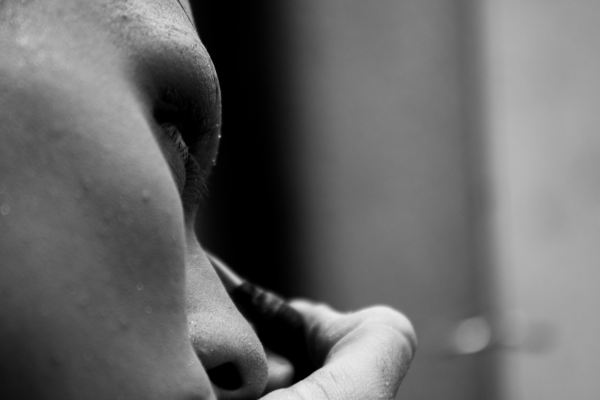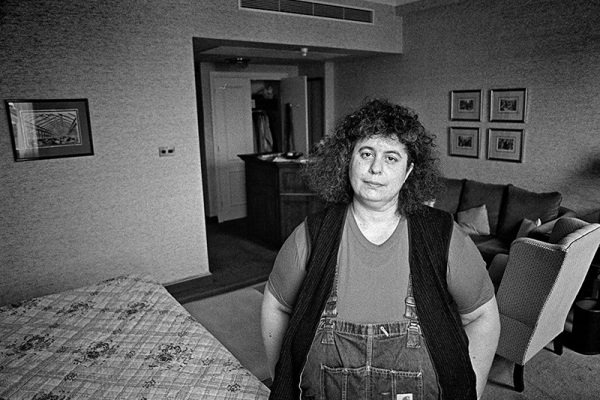Think, as if it were hard, of those moments you will never forget. The phone call in the early morning. The hours spent in that hotel room. The time you decide to meet at his apartment instead of a bar. When you think about your experiences, what shapes do your thoughts assume? Do they stretch to include the larger contexts—longer patterns, structural forces—from which events emerge, or does that risk quieting the way some moments take hold of us with permanence and stunning memorability? What does this dichotomy even afford when it is so often the case that everyday violence is accompanied by the shock of probability fulfilled, and when even after the most unlikely of accidents, you still swear you dimly heard the flapping of a butterfly’s wings?
Vivian, the protagonist of Post-Traumatic, Chantal Johnson’s debut novel published in 2022, is a Black woman in her early thirties who works as a public defense attorney at a New York state psychiatric ward. Early in the novel, she recounts a conversation she had with a white woman named Paula, who works for a similar facility. Paula complains to Vivian that she doesn’t want to go back to work the next day. “Every day it’s the same,” she complains. “Poor, neglected, abused; poor, neglected, abused . . . you know what? Sometimes I wish I had at least one of those ‘adverse childhood experiences.’” “Why would you want that?” Vivian asks. “For the story,” Paula replies.
Yet Post-Traumatic resists the literary tendency to reduce traumatic experience to a well-defined story. “The event,” a singular and almost mythic experience of human suffering, never appears in Post-Traumatic. This is one source of the title’s irony, one of its multiple valences. For a novel that wears its relationship to trauma on its sleeve, its relationship to that word is always a question posed.
Though Post-Traumatic is a novel of development, its bildung occupies a short period of time during Vivian’s adulthood. Vivian has grown up in a poor, working-class family of the sort Paula fetishizes. Her childhood was marked by severe neglect, as well as physical and sexual abuse. After Vivian’s father leaves her struggling and neglectful mother, Anita, she brings “the violent man” into their home. The sexual and physical abuse Anita’s boyfriend inflicts upon Vivian during her childhood appears only briefly, in short but still-horrific glimpses. Aside from these vignettes, Post-Traumatic quietly weaves Vivian’s childhood memories into her present-day adult narrative without aplomb. In avoiding shocking flashbacks or revelatory monologues, this narrative choice aligns with Post-Traumatic’s larger investment in representing harm as diffuse rather than manifest in isolated events. As such, it joins recent calls, from fiction and beyond, to place traumatic experience amid its political contexts. In asking us to recognize the social dimensions of personal harm, these calls urge us to envision what can follow trauma. They ask us, in other words, to try to envision repair.
Post-Traumatic interweaves Vivian’s childhood experiences with her adult life, presenting each timeline as a continuation of the other. Vivian never chronologically recounts the moments where she was assaulted. Rather, they come through in small bursts. Early in the novel, Johnson describes how Vivian and her best friend Jane first met at a party during their first year of law school. The two were some of the only Black women in their class, and Jane later drops out. Vivian, in response to Jane sharing her experiences of childhood abuse, “reciprocate[s] with a bulleted account of her own history.” Vivian remembers “all manner of violence by one of her mother’s boyfriends, hitting and verbal humiliation, she wasn’t allowed to eat when she’d done something bad, and that was just the stuff he did in front of other people.” By the time Vivian recounts these experiences to Jane, she has already contextualized them within the poverty and instability of her upbringing. She tells Jane, too, that she has recovered.
Post-Traumatic suggests that recovery for Vivian relies upon her professional advocacy. She is committed to the sense that “one had to help people, thus her decision to become a lawyer in a psychiatric hospital, working to free people from forced institutionalization by the state.” Vivian “recognize[s] herself” in theories of generational poverty, yet resists how these “overdetermined theories” preclude any possibility of individual or social repair. Instead, she feels “an obligation to her people, those who had survived brutal upbringings . . . someone had to make sure that the most vulnerable members of our society weren’t completely abandoned.” Vivian’s advocacy work, she thinks, allows her and her clients to reclaim agency amid otherwise insurmountable structural forces. She adeptly positions her own history within the structures—systemic racism, institutional neglect, generational poverty—that have formed her individual traumatic experiences. In this way she behaves like a novel itself: more particularly, the realist novel that has long been associated with capturing the relationship between social world and individual.
Post-Traumatic mostly remains close to Vivian in a third-person telling that allows her to constantly frame the events and people around her; to constantly put her experiences in their sociohistorical contexts. In other words, she finds endless ways to represent trauma: she need only look to the shifting relationships between individuals and their social worlds.
It is such a capacity to oscillate between world and individual that enables the novel, as well as other literary genres, to attach linguistic representation to traumatic experience. However, this notion clashes with how we have long understood the relationship between trauma and literary representation. Classical trauma theory asserts that traumatic experience carries with it an aesthetics of unrepresentability. By this logic, formal devices such as fragmentation, linear jumps, or elliptical language draw attention to how traumatic experience refuses literary expression.
In Cathy Caruth’s famous framing, traumatic experience provokes an epistemological crisis that defies representation. For Caruth, trauma can only be reworked into language as ever-belated, incomplete “representation in the form of traumatic effects,” as Marinella Rodi-Risberg has summarized. Traumatic effects, or the psychic symptoms trauma causes, can find visible expression; the experience itself cannot. Such is the dilemma trauma has always appeared to pose for the novel: it begs to be represented even as its representation tests the novel’s limits.
But Post-Traumatic diverges from how classical trauma theory privileges the “event.” It suggests that the novel can capture traumatic experience—by looking back to the scattered, systemic causes behind it at the same time as it looks forward to its effects.
Such a framing aligns more closely with Lauren Berlant’s attention to the “mere banality” that characterizes, for many, living through structural violence. Berlant describes living “in proximity to a suffused violence so systemic. . . it is a relief when an event expresses it.” Post-Traumatic similarly reflects recent calls to shift the framing of mental health crises from “medicalized” frameworks to structural ones. Medicalization, Danielle Carr writes, “puts the focus on the individual. . . at the expense of factoring in systemic and infrastructural conditions.” In other words, it disguises a political problem as a personal one.
These frameworks urge us to foreground structural oppression in how we discuss personal harm. Many of the experiences we call traumatic are expressions of structural violence: possessing clear origins, dragging on, and occurring pervasively. Yet the commonplace language we use to invoke these experiences—my trauma, my story—individualizes them, stripping them from their political and social contexts. I’ve done this myself, in writing an essay about being raped as an example of trauma, instead of the other way around—instead of framing trauma as a psychic byproduct of the socially situated event that rape always is.
It can be difficult, within personal writing’s conventions, to situate individual experience politically or socially. Perhaps we take for granted that the personal will be understood as political, even though it is in many people’s interests to cleave our senses of the two apart. And yet these two scales of experience—singular and structural—don’t always cleanly map onto each other. My trauma is not just a perfect microcosm of structural cruelty. Nor is any form of social violence—state-sanctioned racism, gender-based violence, or institutional attacks against trans people—simply the scaled-up version of one’s individual experience. To represent trauma anecdotally on the one hand and in generalizations on the other: each risks losing something as crucial as it is hard to pin down.
Johnson’s innovation in Post-Traumatic is to locate the intersections of these scales: to find the delicate balance in situating the singular as structural, to help us listen for the butterfly’s wings. The novel’s basic narrative structure features two merging scales. In the first, Vivian moves through basic rhythms (dating, working, occasionally seeing or speaking to family). These events meld with a second set, which contain moments referencing abuse or poverty. These moments break through without breaking the narrative. This is difficult work. Long passages of the novel where these two scales oscillate strain: they’re heavy under the weight of so much detail and Vivian’s own critical musings on this content’s political significance. Each passage tirelessly reworks how individual experience interacts with structural violence.
If the question of how to represent trauma could be answered, what other questions would take its place? As Vivian cycles through framing after framing to explain what’s happened to her, dramatic irony, that narrative device tailor-made to register clashes between individual understanding and structural forces, attaches to her narration—from the “rich sociohistorical context” that describes her childhood to her self-assurance in that she’s fulfilling her “obligation to her people.” It especially follows her in scenes that depict Vivian’s active attempts to rescue her clients from the institutional cruelties that engulf them.
An episode in the novel that functions as a narrative breaking point helps readers understand the source of this lingering irony. One of Vivian’s younger clients at the facility is a teenager named Melissa, who is incarcerated at the hospital after a violent fight with her mother and her mother’s boyfriend, which results in her roaming around New York unhoused for days. Vivian is determined to have her released back home. Before the hearing that will decide Melissa’s possible release, Vivian speaks to Melissa’s mother, who promises she’ll testify in her favor. Vivian is confident the state will rule in Melissa’s favor.
Post-Traumatic’s otherwise gentle irony is harsher here. At the hearing, which occupies the bulk of a chapter titled “So Ordered,” Vivian observes that “the vibe in the courtroom was bleakness tinged with absurdity.” Soon into the hearing, during which multiple patients’ cases are presented, Vivian watches the judge scream at an older Spanish-speaking woman to turn off her cell phone and remove her from the courtroom. In response, Vivian feels “an impulse, inchoate and obscure.” She watches Dr. Creslin, the psychiatrist called in to advise on patients’ release, sworn in. “Creslin had practiced for thirty years,” Vivian knows, “and by this point whatever idealism he might have brought with him into the profession had been replaced by cold pragmatism.” Listening to Creslin recommend that an unhoused Black man remain institutionalized, Vivian perceives the “subtext” at hand. “What Creslin was really saying was that this was your garden-variety paranoid schizophrenic black male” who is “wholly unassimilable,” Vivian intuits. She watches as the state actors behind her patients’ seemingly predetermined fates each play their assigned role.
Early in 2023, several media outlets declared that Jordan Neely had experienced a form of “social death” even before his actual murder on the New York City subway. Post-Traumatic’s courtroom montage makes vivid how such “social death,” far from being predetermined, results from willing participants like Creslin actively implementing structural cruelties onto vulnerable people. One by one, the hearings continue: “a black man . . . despite his attorney arguing that he was suffering from temporary drug-induced psychosis he was ordered to be recommitted” while “the white lawyer who had a manic episode after not getting a job offer from the law firm of his dreams” is released to his family’s care. Johnson never allows any insight into these characters’ emotional landscapes. She need not appeal to individual experience, rendering it visible as traumatic, in order to make vivid how horribly wrong the courtroom events are.
Inexplicably, Vivian continues to believe that upon pleading her case, Melissa’s fate might be different. Vivian cross-examines Creslin, who labels Melissa a danger to others and suggests they continue to “get the behavior under control with a sedative.” Vivian is as rigorous and meticulous as a lawyer on television, elaborating upon “diagnostic racism, ‘the invisible third party whenever a white doctor examines a black or brown patient in distress,’” until the judge threatens to find her in contempt. As Ruby, Melissa’s mother takes the stand, Vivian notices that she “had difficulty making eye contact with Vivian . . . which made sense, given Melissa’s wrenching testimony” about her challenging relationship with her mother. Vivian imagines that “once Melissa [is released], Vivian would recommend that the two of them enter family therapy together. One of the social workers had mentioned a feminist therapist who specialized in helping women overcome the aftereffects of violence.” But on the stand, Ruby betrays Melissa, refusing to corroborate her daughter’s testimony. Melissa is sentenced to remain in the hospital as Vivian’s fantasies of repair collapse. Vivian watches as Melissa is strapped down and sedated after reacting angrily to the judge’s decision. When the hearing ends, Vivian walks to her office, gathers her things, and quits, leaving the hospital for the last time. She never sees Melissa again.
At this point, Post-Traumatic shifts in both content and form. The previous narrative about Vivian’s work and dating lives, her friendship with Jane, and her fraught interactions with her family becomes looser. After Matt, a musician Vivian became fixated on after a few dates, breaks things off, she decides to seduce Paula’s husband. After a fight with Jane, the two women stop speaking. Without a job, Vivian lives off savings; without Jane, she seeks out other friends. Much of this portion of the novel exudes desperation. Vivian roams from person to person, situation to situation, seeking some thing or experience or quality to replace what she has lost.
Absent the vision of social repair her job once allowed her, Vivian loses a blueprint of how to live. Even as the novel ironized her now-lost belief—that she as an individual might reform broken social structures—she still clung to it. One reading of the novel would find Vivian’s erratic, desperate behavior post-traumatic syndromes of her childhood abuse, let loose without the structure of her job. But this reading would diminish Post-Traumatic’s social and political vision, and obscure what’s at stake for the novel in its attention to traumatic experience’s structural dimensions. Vivian’s job allowed her to believe a single person could challenge institutional, state-sanctioned cruelties on her own. With the collapse of that fantasy, Vivian does not lose her ability to represent and comprehend traumatic experience. Instead, she loses her understanding of how to live, which was always intertwined with the possibility of social repair.
For a while after she leaves her job, Vivian continues to spiral. Paula’s husband rejects her, and around the same time she cuts off ties completely with her family, who call the police to perform a wellness check. When the police arrive, she panics until she calls Jane, who walks her through complying with the officers until they leave. As she reconciles with Jane, Vivian begins to rediscover new, tentative ways of situating herself within her social world. Although she flounders for a while longer, a shift occurs. It’s at this point in the novel when Vivian begins to write.
Much ink has been spilled about the antagonistic relationship between language and trauma. Yet it has always seemed that repair is the wilder, more fleeting and precarious antagonist to language. How does one write about repair without falling prey to twinned demons? On one side lies bourgeois individualism, individual “healing” stripped of social urgency; on the other, social determinism that would strip the individual of any agency at all.
Vivian’s writing first begins to appear in Post-Traumatic feverishly. It occurs in italicized snippets visible as intrusions into Post-Traumatic’s narrative space. “THIS OBJECT HAS BECOME A SUBJECT,” Vivian narrates to herself in a strange fervor after nearly being sexually harassed on the subway. Gazing at her face and all its ostensible flaws in the mirror one day, “suddenly, Vivian had an idea for a book,” in which “an ugly woman manages to conceal her ugliness by elaborately tensing the muscles in her face. Her labored beauty attracts a man whose beauty is naturally occurring and the two of them marry and enjoy a happy life together for years until one day.” The fairy tale continues. Vivian’s writing reworks her reality, gifting a critical distance that allows her to perceive and then edit experiences as they transpire.
The conflation of authorship with recovery from traumatic experience is so storied that it risks cliché. Nonetheless, as Post-Traumatic draws to a close, Vivian begins to write. Perhaps it is more accurate to say that as Vivian begins to write, we are meant to infer the novel is beginning to end. If there were anything that could be said to defy representation, it would be this: the miraculous fact of one day noticing yourself on the other side of what has happened to you, outside all probability and explanation. The novel approaches its conclusion and Vivian draws nearer to repair.
These writerly forays or experiments also function as commentary on the literary form itself, and its ability to collide individual and social spheres. Vivian, this novel, and many novels are well-equipped to represent the dimensions of traumatic experience. Just as Vivian switches from one aesthetic mode to the next, from critique to humor to fictional imaginaries, so too does the novel roam through structural, political, and individual dimensions. Though the voices of classic trauma theory have helped to cement our notion of traumatic experience as defying representation, other voices have always been whispering otherwise.
I was raped for the second time in my life a few years ago, a few weeks after completing my orals exam, that moment in one’s doctoral program when you decide what you’ll write about for years to come. For a long time after I couldn’t write about anything at all. What happened to me was so brutal and extreme that it was difficult to see it as anything other than an anomaly, and it arrested me in many ways. Finally, when I was at risk of leaving my graduate program, I thought about writing something about rape—which also meant writing about the structural conditions that produce it, the forms that represent it, and whatever repair can follow. I noticed something inside me begin to move as my attachment to the subject evolved from something wordlessly felt to something critically understood. The thrill of sublimation, maybe. But maybe, too, something more.
As Vivian continues to write her novel, the hole in Post-Traumatic’s center left by her abrupt departure at the hospital remains a gaping wound. “She would never forget her clients, survivors all,” she says to herself whenever she thinks about her former clients, which is often. Post-Traumatic refuses to resolve this wound. No gestures at unlikely happy endings for Melissa and the others will appear. Nor does Post-Traumatic imply an individualistic path of healing for Vivian taken at her clients’ expense. To do either would endorse the logic that we are stronger when we put our own life vests on first before helping others: bloated logic that so many of us have stretched so thin. Instead, Post-Traumatic wrestles with genuine ambivalence about the fact that Vivian recovers while others do not. The novel, in these final moments, treats Vivian’s recovery as a breathlessly precarious fact—as unfair as it is magical, as arbitrary as it is gorgeous.
When the novel draws to a close, the narrative voice that had once stayed so close to Vivian widens its gaze. It describes, in broad strokes, other actions Vivian begins to take that we might call reparative. She begins to read personal essays by other women who’ve also navigated familial estrangement, whose stories Post-Traumatic movingly summarizes. She joins an online forum for estranged adults and asks for help in navigating possible future wellness checks from her family. “I know that you will get through this,” one user writes in response. Italicized like the snippets from Vivian’s developing novel, it is as if textual intrusions linked to repair in Post-Traumatic draw attention to themselves even as they remain separate from the narrative itself.
Vivian also begins to see a therapist, Lisa. Their sessions feel like Vivian’s other new experiences: social acts of attention and care. When Vivian describes to Lisa being forced to abandon her childhood cat, Noodles, because her mother’s boyfriend disliked him, they both cry together. Her responses to Vivian foster something akin to solidarity, or even love. No matter the exact form it takes—Jane’s care for Vivian, the anonymous women online, Lisa’s displays of empathy—repair in Post-Traumatic occurs collectively. Frameworks for repair—psychoanalytic, economic, structural—abound, yet each invariably positions repair as a relational process that exceeds a single self’s capacities.
The contradictions of repair are just as many as the ones related to representing trauma. Despite this—or maybe because of this—contemporary novelists are envisioning how to represent repair, which also means how to imagine it. As the editors of Parapraxis have recently written, “we write from a moment that seems beyond repair, and yet some still call for this form of redress” even when “the old forms of ‘cure’ or even ‘healing’ are no longer available, trustworthy, or sufficient.” Vivian’s work, all our work, is “indefinite work without closure.” Yet I too have found that both pain and promise lie in mapping, explaining, and representing harm. As Vivian begins to do just that, Post-Traumatic ends. And so the opening left by the novel’s ending feels more like a beginning: a set of searching questions that crawl toward a light made visible by the opening of a wound.
We’re interested in what you think. Submit a letter to the editors at letters@bostonreview.net. Boston Review is nonprofit, paywall-free, and reader-funded. To support work like this, please donate here.








